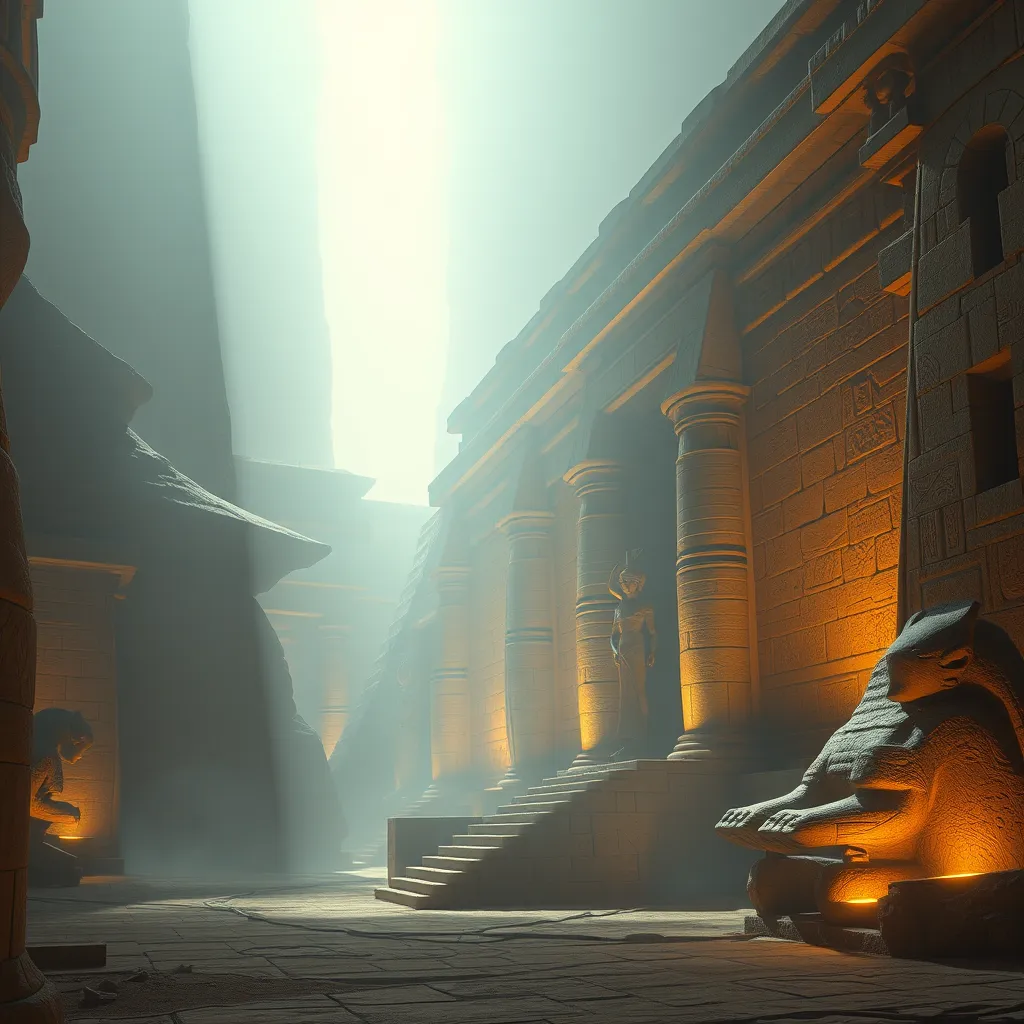The Duat: A Realm of Eternal Light and Shadows
I. Introduction
The Duat, in ancient Egyptian cosmology, is a complex and significant realm that represents the afterlife. It is often depicted as a place where the souls of the deceased traverse, encountering various challenges and deities. The concept of the Duat encapsulates the duality of existence, embodying both light and shadows, which are essential to understanding the ancient Egyptians’ perception of life after death.
This article aims to explore the multifaceted nature of the Duat, examining its historical context, structure, associated deities, the journey of the soul, symbols, and its influence on modern spirituality.
II. Historical Context of the Duat
The origins of the Duat can be traced back to early Egyptian religious beliefs, where it was initially seen as a shadowy realm beneath the earth. Over time, the concept evolved, reflecting the changing attitudes towards death and the afterlife across various dynasties.
- During the Old Kingdom, the Duat was primarily viewed as a dark, chaotic space.
- In the Middle Kingdom, texts began to emphasize the idea of a journey through the Duat, focusing on the trials one must face.
- The New Kingdom saw the Duat being portrayed more positively, with the inclusion of heavenly elements.
The Duat is prominently featured in funerary texts such as the Pyramid Texts and the Book of the Dead, guiding the deceased through the afterlife’s challenges and rituals.
III. The Structure of the Duat
The Duat is often depicted as a vast, complex realm with various regions, each representing different aspects of the afterlife. Some of the notable regions include:
- The Field of Reeds: A paradise where the righteous enjoy eternal life.
- The Hall of Two Truths: Where the Weighing of the Heart ceremony occurs.
- The Lake of Fire: A place of punishment for the wicked.
The landscape of the Duat is rich with symbolism. Light represents order, truth, and the divine, while darkness symbolizes chaos and the unknown. The journey of the soul through these realms is a critical aspect of the afterlife experience.
IV. Deities Associated with the Duat
Several deities play significant roles in the Duat, each contributing to the journey and judgment of the deceased:
- Anubis: The guardian of the dead, responsible for guiding souls and overseeing the mummification process.
- Osiris: The god of the afterlife and resurrection, who judges the souls in the Hall of Two Truths.
- Thoth: The god of wisdom, who records the results of the Weighing of the Heart ceremony.
These deities embody the duality of light and darkness, each representing different aspects of the afterlife journey.
V. The Journey of the Soul
Upon death, the soul embarks on a journey through the Duat, which is filled with trials and tribulations. The journey typically includes the following stages:
- Initial passage through the gates of the Duat.
- Confrontation with various monstrous guardians.
- The crucial Weighing of the Heart ceremony, where the heart of the deceased is weighed against the feather of Ma’at.
The Weighing of the Heart is particularly significant as it determines the soul’s fate. If the heart is lighter than the feather, the soul is deemed worthy and allowed to enter the Field of Reeds. If heavier, it faces annihilation.
VI. Symbols and Artifacts of the Duat
Ancient Egyptian art and artifacts are replete with symbols representing the Duat. Some key symbols include:
- The Ankh: Symbolizing life and immortality.
- The Scarab: Representing rebirth and transformation.
- The Feather of Ma’at: Symbolizing truth and justice.
Funerary artifacts, such as amulets and the Book of the Dead, were essential for navigating the Duat. These items not only provided protection but also served as guides for the deceased in the afterlife.
In contemporary culture, these symbols continue to resonate, inspiring modern interpretations and adaptations in art and spirituality.
VII. The Duat in Modern Spirituality
The concept of the Duat has influenced various modern esoteric and spiritual practices. Its themes of transformation, judgment, and the duality of light and darkness resonate with many contemporary belief systems. Comparisons can be drawn between the Duat and other cultural afterlife beliefs, such as:
- The Christian concept of Heaven and Hell.
- The Buddhist idea of reincarnation and the cycle of suffering.
- The Greek underworld, ruled by Hades.
In the context of personal transformation, the Duat symbolizes the inner journey one must undertake, facing one’s fears and shadows to achieve enlightenment and spiritual growth.
VIII. Conclusion
The Duat stands as a profound symbol of the ancient Egyptians’ understanding of life, death, and the afterlife. Its duality of light and shadows reflects the complexities of existence, offering insights into the human experience. As we explore the rich tapestry of beliefs surrounding the Duat, we are invited to reflect on its enduring legacy and its relevance in our understanding of life and transformation.
Further exploration of ancient Egyptian beliefs reveals a wealth of knowledge that continues to influence modern spirituality and philosophical thought. The Duat, as a realm of eternal light and shadows, invites us to contemplate our own journeys through life and beyond.




